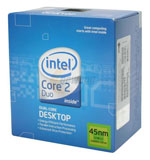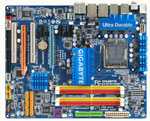Intel Value Midrange
The Phenom II has made AMD competitive through the midrange while Intel still dominates the high-end with Core i7. That means you can now choose Intel or AMD midrange system based on the features of each platform or expansion capabilities, rather than CPU brand. Since Phenom II uses a 45nm process, even overclocking capabilities are now competitive with Intel's Core 2 series.
The Intel value midrange builds around a fast Intel Core 2 Duo CPU. For most applications and gaming a faster dual-core chip is normally a better performance choice than a slower quad-core alternative, not to mention they're usually less expensive. CPU intensive applications like video ripping do benefit from a quad-core CPU, which should be your choice if those applications are important to you. A few recent games are finally taking advantage of quad-core as well, although gaming performance is normally about the same whether a CPU is dual-core or quad-core.
| Intel Value Midrange PC | ||
| Hardware | Component | Price |
| Processor | Intel Core 2 Duo E8400 Wolfdale 65W 45nm (3.0GHzx2, 6MB L2) | $166 |
| Cooling | Intel Retail HSF | $ - |
| Motherboard | GIGABYTE GA-EP45-UD3P (after $20 Rebate) | $115 |
| Video | HIS H487FN1GP Radeon HD 4870 1GB (after $20 Rebate) | $130 |
| Memory | 4GB DDR2-1150 OCZ Blade OCZ2B1150LV4GK 5-5-5-15 at 1.8v | $80 |
| Hard Drive | Western Digital Caviar Black 1TB WD1001FALS | $95 |
| Optical Drive | Sony Optiarc 24X DVD - AD-7240S | $32 |
| Audio | On-Board | $ - |
| Case | ANTEC Three Hundred ATX Mid Tower | $60 |
| Power Supply | OCZ ModXStream Pro 600W OCZ600MXSP Modular SLI Certified CrossFire Ready 80 PLUS Certified (after $20 Rebate) | $60 |
| Base System Total | $738 | |
| Display | Acer X233Hbid 23" 5ms HDMI Widescreen 16:9 Full HD 1080P LCD Monitor (1920x1080) | $180 |
| Speakers | Logitech X-540 70 watts 5.1 Speaker - Retail | $79 |
| Input | Microsoft CA9-00001 Black PS/2 Standard Keyboard and Optical USB/PS2 Mouse - OEM | $16 |
| Operating System | Microsoft Vista Home Premium OEM | $99 |
| Complete System Bottom Line | $1112 | |
 |
The CPU choice is the excellent E8400 Core 2 Duo chip at 3.0GHz with 6MB of L2 cache. The 3.00GHz speed is just two steps below the fastest Core 2 E8600 that clocks in at 3.33GHz. The E8400 also overclocks exceptionally well, reaching 4GHz and even higher with relative ease. Because of this overclocking ability and the value goal of this system build, we paired the E8400 with components that are also excellent choices for overclocking. This Intel system is ready to overclock to wherever your particular E8400 can go. The stock Intel cooler is adequate for modestly overclocking a Core 2 Duo, but it ceases to be effective before your E8400 reaches its top performance level. If extreme overclocking is your cup of tea you should replace the stock Intel HSF with a better cooler like the Xigmatek HDT-S1283 120mm Rifle Cooler ($27 after a $10 rebate) that is featured in our AMD value midrange build on page four.
 |
The big brother to the UD3R selected in our sub-$800 guide is the $135 GIGABYTE GA-EP45-UD3P that has a similar feature set but adds a second x16 slot (in place of a PCI slot) for dual x8 CrossFire operation. You can currently save a few bucks with a $20 mail-in rebate. The board provides an excellent overclocking platform along with great stability. If the second x16 slot is not important to you, we suggest sticking with the UD3R. This P45 chipset motherboard has earned its reputation as an excellent overclocker while also exhibiting excellent stability. It is a good match to the selected Core 2 Duo E8400 or an alternate Quad-Core Q8200 (2.33GHz).
The memory choice for the Intel value midrange is some of the fastest memory we have tested - the OCZ Blade DDR2-1150 4GB kit. Perhaps even more important is the very low voltage needed for performance with the dual-channel Blade memory. It is rated at 5-5-5 timings at DDR2-1150 and just 1.8V. The low voltage design provides more overclocking headroom. This OCZ kit is more expensive than we normally chose for a value midrange system, but at $80 it is still a great performance value and is worth the cost.










71 Comments
View All Comments
SiliconDoc - Wednesday, August 5, 2009 - link
The idea that the 4870 or the 4890 beats the GTX275 is a FANTASY.-
http://www.driverheaven.net/reviews.php?reviewid=7...">http://www.driverheaven.net/reviews.php?reviewid=7...
http://www.bit-tech.net/hardware/graphics/2009/04/...">http://www.bit-tech.net/hardware/graphi...03/radeo...
http://www.bjorn3d.com/read.php?cID=1539&pageI...">http://www.bjorn3d.com/read.php?cID=1539&pageI...
http://www.dailytech.com/422009+Daily+Hardware+Rev...">http://www.dailytech.com/422009+Daily+H...adeon+HD...
http://www.guru3d.com/article/geforce-gtx-275-revi...">http://www.guru3d.com/article/geforce-gtx-275-revi...
http://www.legitreviews.com/article/944/15/">http://www.legitreviews.com/article/944/15/
http://www.overclockersclub.com/reviews/nvidia_3d_...">http://www.overclockersclub.com/reviews/nvidia_3d_...
http://www.hardwarecanucks.com/forum/hardware-canu...">http://www.hardwarecanucks.com/forum/ha...a-geforc...
http://hothardware.com/Articles/NVIDIA-GeForce-GTX...">http://hothardware.com/Articles/NVIDIA-GeForce-GTX...
http://www.engadget.com/2009/04/02/nvidia-gtx-275-...">http://www.engadget.com/2009/04/02/nvid...275-ati-...
http://www.overclockersclub.com/reviews/nvidia_gtx...">http://www.overclockersclub.com/reviews/nvidia_gtx...
http://www.pcper.com/article.php?aid=684&type=...">http://www.pcper.com/article.php?aid=684&type=...
-
If you're spending $700.00 to $1,600 dollars and a $15 difference on one of your most important components, the videocard, makes your mind up for you... well...
---
NVidia often has 1 or TWO free games with it at the egg - while the red card far less often has just 1. There's another $50 - or $100, going with Nvidia - because of course with either card that makes it a GAMING system - and one would need some games.
---
I wasn't surprised that EVERY CARD in EVERY SYSTEM recommended was the red rooster card - considering where we are.
Mirrorblade - Monday, July 27, 2009 - link
Hiya, for HDD choice you write"While there are differences between hard drives, outside of running benchmarks most people aren't likely to notice the difference in performance between Western Digital, Seagate, Samsung, Hitachi, and other major brands." -
but for memory, you recommend an overclocking memory set, where you could easily save some money (and you don't even give an alternative "for the people that will never want to overclock at all).
.. I don't see any point in advising only overclocking stuff. Sure one might want to overclock, but in this case you could add something as an alternativ, not recommend the OC stuff in general.
Wesley Fink - Monday, July 27, 2009 - link
Even if you never overclock the low-voltage designs of the memory we recommend in the Guide will perform well and last a last time. You can certainly substitute lower cost and lower spec'ed memory if that better meets your needs.Search for a standard like DDR2-800 for the DDR2 systems and DDR3-1066 or 1333 for the Performance mid-range systems. Name brand memory with a real warranty is the better choice - even at the low end. If anything goes wrong quality memory suppliers will replace the bad memory quickly and many better companies offer a lifetime memory warranty.
In comparing memory at the same price choose the one that has the tighter timings, like 5-5-5 instead of 7-7-7. At the same timings and price the one that is specified with the lower voltage is generally the better choice.
nafhan - Monday, July 27, 2009 - link
I think they recommended overclocking memory because they are recommending overclocking in general at this price point. Notice the processor and motherboard choices are geared towards overclocking as well. If you are definitely NOT going to overclock the value midrange, you could buy cheaper memory, motherboard, and (on the AMD side) a non-black edition CPU. You'd save about $100, and still have a fast, reliable system.It might be interesting if they listed a non-overclocking alternative for those parts (Mem, CPU, MB). Although, that may just push things down into the "budget" system range.
IlllI - Monday, July 27, 2009 - link
can anyone tell me if the OCZ ModXStream Pro is better than the ENERMAX PRO82+ http://www.newegg.com/Product/Product.aspx?Item=N8...">http://www.newegg.com/Product/Product.aspx?Item=N8... ? they are both about the same priceThe0ne - Monday, July 27, 2009 - link
I don't know about the enermax but I've researched before purchasing my OCZ 700W PS. Their lower wattage PS have good reviews except for this one but with the recent updates it's gotten better reviews. It was below average before. Sorry I don't have the link to the website that reviews PS.One thing to keep in mind is that if you're not really going to use the max wattage then I wouldn't worry about it. Also, it's best to know your system configuration and try to get a PS with some buffer wattage just in case....you know like when it ages :)
Wesley Fink - Monday, July 27, 2009 - link
Today's price on the OCZ Modular 600W is $50 after a $20 rebate, or an initial cost of $70. The Enermax is a decent PSU, but current cost is $60 after a $50 rebate or an initial cost of $110.The OCZ slightly higher power rating, modular design, and 3-year warranty tilt the value toward the OCZ. Both units are 80 Plus certified, and OCZ has an excellent reputation for Customer Service.
C'DaleRider - Monday, July 27, 2009 - link
That OCZ ModXStream isn't even in the same class as the Enermax Pro82+. Interior construction----the OCZ uses Chinese off-brand capacitors while the Enermax uses high quality name brand Japanese capacitors.Efficiency----not even a contest, the Enermax by a landslide.
Voltage regulation and ripple/noise suppression----again, the Enermax trounces the OCZ.
In all, the OCZ is a mediocre power supply that failed testing when subjected to temps above 40C. On the other hand, the Enermax is better constructed, more efficient, and flew through testing despite being subjected to temps in excess of 40C.
You make the call.
jonup - Monday, July 27, 2009 - link
First the Enermax comes with $50 MIR. Which is a turnoff for many.Second, I just bought OCZ ModXStream Pro 600W (it should ship today) and I did some reading before I bought it. Non of the reviews had an issue with the performance. It performed as rated or better with stable voltages.
Third, for a midrange system it should be running in less then 400-450. At such output the OCZ if working 2 85-86% efficiency. I am not saying that it is better than the Enermax, but in worst case the OCZ will be behind 1-2% which is immaterial.
erple2 - Monday, July 27, 2009 - link
My system (non-overclocked E6750, radeon 4890, 2 memory sticks etc) eats about 325 W at the wall when running at or near full tilt. Factoring in even the highest efficiency available for my PSU (85%), the system is using about 275W of power. I think that the midrange systems listed here (particularly the lower midrange ones) will be chewing through about 300W at full tilt. So I think that the 600W psu should be more than enough.Yes, you can play games with specific efficiencies at specific wattages, but for that you're going to need to see the charts to make that fine-tuned an estimate. But, most power supplies that I've seen reviews for hit max efficiencies between 30 and 60% utilization.
Also, does that extra few percentage of watts make that much of a difference? I dunno. Turn off a light instead. That will save you more power.